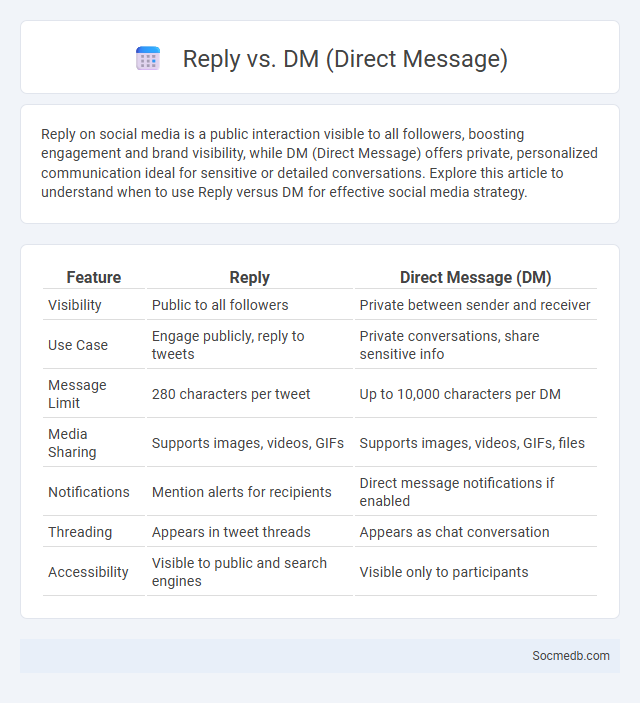
Photo illustration: Reply vs DM (Direct Message)
Reply on social media is a public interaction visible to all followers, boosting engagement and brand visibility, while DM (Direct Message) offers private, personalized communication ideal for sensitive or detailed conversations. Explore this article to understand when to use Reply versus DM for effective social media strategy.
Table of Comparison
| Feature | Reply | Direct Message (DM) |
|---|---|---|
| Visibility | Public to all followers | Private between sender and receiver |
| Use Case | Engage publicly, reply to tweets | Private conversations, share sensitive info |
| Message Limit | 280 characters per tweet | Up to 10,000 characters per DM |
| Media Sharing | Supports images, videos, GIFs | Supports images, videos, GIFs, files |
| Notifications | Mention alerts for recipients | Direct message notifications if enabled |
| Threading | Appears in tweet threads | Appears as chat conversation |
| Accessibility | Visible to public and search engines | Visible only to participants |
Understanding Replies: Definition and Usage
Replies on social media are direct responses to posts or comments, facilitating interactive communication and enhancing engagement. Understanding replies allows you to effectively participate in conversations, clarify information, and build relationships with other users. Mastering the use of replies boosts your online presence by encouraging meaningful dialogue and increasing visibility within your network.
What is a DM (Direct Message)?
A DM (Direct Message) is a private communication channel within social media platforms that allows you to send messages directly to another user without public visibility. These messages can include text, images, videos, and links, facilitating confidential and personal interactions. Understanding how to use DMs effectively can enhance your social networking experience by enabling discreet conversations and quick exchanges.
Key Differences: Reply vs DM
Replies on social media are public responses visible to all users, facilitating open conversations and engagement on posts. Direct Messages (DMs) offer a private communication channel allowing you to share sensitive information or have one-on-one interactions without public visibility. Understanding these key differences helps you choose the appropriate method for effective communication and privacy.
When to Use a Reply
Using a reply on social media is essential when you want to engage directly with a specific comment or question, ensuring clear communication and fostering a sense of conversation. Replies help maintain context and relevance in interactions, making it easier for Your audience to follow the discussion and feel valued. Timely replies can enhance user engagement and build stronger online relationships.
When to Choose a DM
Choosing a direct message (DM) on social media is ideal when your communication requires privacy, confidentiality, or a personalized touch that public comments cannot provide. You should opt for a DM to address queries, share sensitive information, or build one-on-one relationships with followers. Your ability to respond promptly and discreetly through a DM enhances engagement and trust effectively.
Privacy Implications: Reply vs DM
Choosing between a public reply and a direct message (DM) on social media significantly impacts user privacy. Public replies expose conversations to a broader audience, potentially revealing personal information and increasing risks of data misuse. Using DMs confines communication to private channels, enhancing confidentiality and reducing exposure to third parties or unauthorized data access.
Engagement and Visibility: Which One Wins?
Engagement drives meaningful interactions through likes, comments, and shares, fostering community trust and loyalty on social media platforms. Visibility ensures content reaches a broad audience, increasing brand awareness and attracting potential followers or customers. Balancing high engagement with wide visibility maximizes the impact of social media campaigns, making neither aspect solely victorious but collaboratively essential.
Etiquette: Best Practices for Replies and DMs
Maintaining proper social media etiquette involves responding promptly and courteously to replies and direct messages, ensuring your tone remains respectful and clear. You should personalize responses to show genuine engagement and avoid generic or automated replies that may seem insincere. Prioritize transparency and privacy by not sharing sensitive information in public replies and respecting personal boundaries within DMs.
Common Mistakes with Replies and DMs
Common mistakes in social media replies and DMs include delayed responses, generic messages, and ignoring customer inquiries, which damage brand reputation and engagement. Personalized, timely replies enhance user experience and foster stronger online relationships. Utilizing automated tools with human oversight improves efficiency while maintaining authenticity in interactions.
Choosing the Right Communication Method
Selecting the right communication method on social media depends on your audience's preferences and the message's purpose. Visual content like images and videos often generates higher engagement, while concise text messages work best for quick updates or announcements. Understanding your social media platform's strengths helps you connect with your audience effectively and amplify your brand's impact.
 socmedb.com
socmedb.com